Brian Kingsbury
BiRQ: Bi-Level Self-Labeling Random Quantization for Self-Supervised Speech Recognition
Sep 18, 2025Abstract:Speech is a rich signal, and labeled audio-text pairs are costly, making self-supervised learning essential for scalable representation learning. A core challenge in speech SSL is generating pseudo-labels that are both informative and efficient: strong labels, such as those used in HuBERT, improve downstream performance but rely on external encoders and multi-stage pipelines, while efficient methods like BEST-RQ achieve simplicity at the cost of weaker labels. We propose BiRQ, a bilevel SSL framework that combines the efficiency of BEST-RQ with the refinement benefits of HuBERT-style label enhancement. The key idea is to reuse part of the model itself as a pseudo-label generator: intermediate representations are discretized by a random-projection quantizer to produce enhanced labels, while anchoring labels derived directly from the raw input stabilize training and prevent collapse. Training is formulated as an efficient first-order bilevel optimization problem, solved end-to-end with differentiable Gumbel-softmax selection. This design eliminates the need for external label encoders, reduces memory cost, and enables iterative label refinement in an end-to-end fashion. BiRQ consistently improves over BEST-RQ while maintaining low complexity and computational efficiency. We validate our method on various datasets, including 960-hour LibriSpeech, 150-hour AMI meetings and 5,000-hour YODAS, demonstrating consistent gains over BEST-RQ.
Self-Supervised Pre-Training with Equilibrium Constraints
Aug 27, 2025Abstract:Self-supervised pre-training using unlabeled data is widely used in machine learning. In this paper, we propose a new self-supervised pre-training approach to dealing with heterogeneous data. Instead of mixing all the data and minimizing the averaged global loss in the conventional way, we impose additional equilibrium constraints to ensure that the models optimizes each source of heterogeneous data to its local optima after $K$-step gradient descent initialized from the model. We formulate this as a bilevel optimization problem, and use the first-order approximation method to solve the problem. We discuss its connection to model-agnostic meta learning (MAML). Experiments are carried out on self-supervised pre-training using multi-domain and multilingual datasets, demonstrating that the proposed approach can significantly improve the adaptivity of the self-supervised pre-trained model for the downstream supervised fine-tuning tasks.
Granite-speech: open-source speech-aware LLMs with strong English ASR capabilities
May 14, 2025Abstract:Granite-speech LLMs are compact and efficient speech language models specifically designed for English ASR and automatic speech translation (AST). The models were trained by modality aligning the 2B and 8B parameter variants of granite-3.3-instruct to speech on publicly available open-source corpora containing audio inputs and text targets consisting of either human transcripts for ASR or automatically generated translations for AST. Comprehensive benchmarking shows that on English ASR, which was our primary focus, they outperform several competitors' models that were trained on orders of magnitude more proprietary data, and they keep pace on English-to-X AST for major European languages, Japanese, and Chinese. The speech-specific components are: a conformer acoustic encoder using block attention and self-conditioning trained with connectionist temporal classification, a windowed query-transformer speech modality adapter used to do temporal downsampling of the acoustic embeddings and map them to the LLM text embedding space, and LoRA adapters to further fine-tune the text LLM. Granite-speech-3.3 operates in two modes: in speech mode, it performs ASR and AST by activating the encoder, projector, and LoRA adapters; in text mode, it calls the underlying granite-3.3-instruct model directly (without LoRA), essentially preserving all the text LLM capabilities and safety. Both models are freely available on HuggingFace (https://huggingface.co/ibm-granite/granite-speech-3.3-2b and https://huggingface.co/ibm-granite/granite-speech-3.3-8b) and can be used for both research and commercial purposes under a permissive Apache 2.0 license.
CAV-MAE Sync: Improving Contrastive Audio-Visual Mask Autoencoders via Fine-Grained Alignment
May 02, 2025Abstract:Recent advances in audio-visual learning have shown promising results in learning representations across modalities. However, most approaches rely on global audio representations that fail to capture fine-grained temporal correspondences with visual frames. Additionally, existing methods often struggle with conflicting optimization objectives when trying to jointly learn reconstruction and cross-modal alignment. In this work, we propose CAV-MAE Sync as a simple yet effective extension of the original CAV-MAE framework for self-supervised audio-visual learning. We address three key challenges: First, we tackle the granularity mismatch between modalities by treating audio as a temporal sequence aligned with video frames, rather than using global representations. Second, we resolve conflicting optimization goals by separating contrastive and reconstruction objectives through dedicated global tokens. Third, we improve spatial localization by introducing learnable register tokens that reduce semantic load on patch tokens. We evaluate the proposed approach on AudioSet, VGG Sound, and the ADE20K Sound dataset on zero-shot retrieval, classification and localization tasks demonstrating state-of-the-art performance and outperforming more complex architectures.
A Non-autoregressive Model for Joint STT and TTS
Jan 15, 2025Abstract:In this paper, we take a step towards jointly modeling automatic speech recognition (STT) and speech synthesis (TTS) in a fully non-autoregressive way. We develop a novel multimodal framework capable of handling the speech and text modalities as input either individually or together. The proposed model can also be trained with unpaired speech or text data owing to its multimodal nature. We further propose an iterative refinement strategy to improve the STT and TTS performance of our model such that the partial hypothesis at the output can be fed back to the input of our model, thus iteratively improving both STT and TTS predictions. We show that our joint model can effectively perform both STT and TTS tasks, outperforming the STT-specific baseline in all tasks and performing competitively with the TTS-specific baseline across a wide range of evaluation metrics.
Bilevel Joint Unsupervised and Supervised Training for Automatic Speech Recognition
Dec 11, 2024Abstract:In this paper, we propose a bilevel joint unsupervised and supervised training (BL-JUST) framework for automatic speech recognition. Compared to the conventional pre-training and fine-tuning strategy which is a disconnected two-stage process, BL-JUST tries to optimize an acoustic model such that it simultaneously minimizes both the unsupervised and supervised loss functions. Because BL-JUST seeks matched local optima of both loss functions, acoustic representations learned by the acoustic model strike a good balance between being generic and task-specific. We solve the BL-JUST problem using penalty-based bilevel gradient descent and evaluate the trained deep neural network acoustic models on various datasets with a variety of architectures and loss functions. We show that BL-JUST can outperform the widely-used pre-training and fine-tuning strategy and some other popular semi-supervised techniques.
Exploring the limits of decoder-only models trained on public speech recognition corpora
Jan 31, 2024



Abstract:The emergence of industrial-scale speech recognition (ASR) models such as Whisper and USM, trained on 1M hours of weakly labelled and 12M hours of audio only proprietary data respectively, has led to a stronger need for large scale public ASR corpora and competitive open source pipelines. Unlike the said models, large language models are typically based on Transformer decoders, and it remains unclear if decoder-only models trained on public data alone can deliver competitive performance. In this work, we investigate factors such as choice of training datasets and modeling components necessary for obtaining the best performance using public English ASR corpora alone. Our Decoder-Only Transformer for ASR (DOTA) model comprehensively outperforms the encoder-decoder open source replication of Whisper (OWSM) on nearly all English ASR benchmarks and outperforms Whisper large-v3 on 7 out of 15 test sets. We release our codebase and model checkpoints under permissive license.
Joint Unsupervised and Supervised Training for Automatic Speech Recognition via Bilevel Optimization
Jan 13, 2024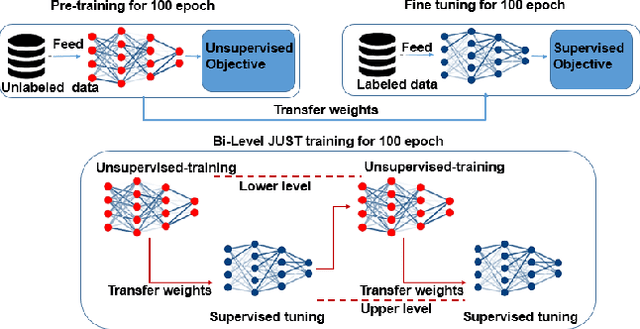
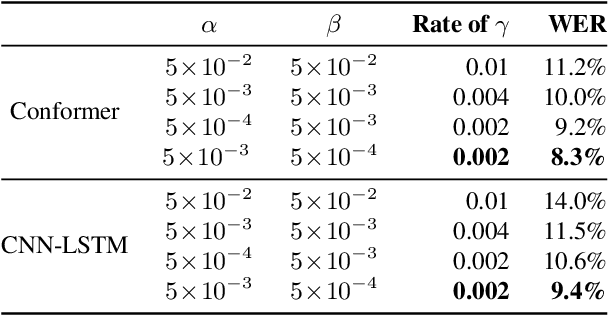
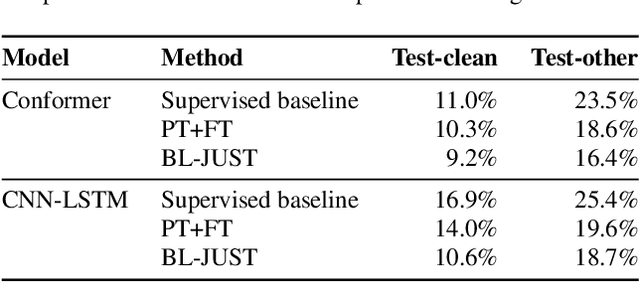
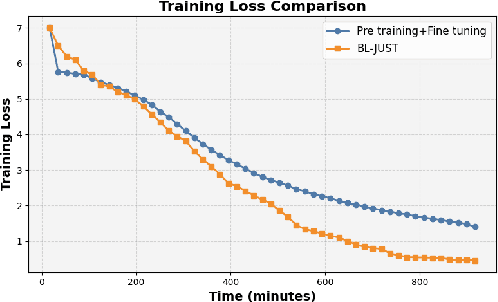
Abstract:In this paper, we present a novel bilevel optimization-based training approach to training acoustic models for automatic speech recognition (ASR) tasks that we term {bi-level joint unsupervised and supervised training (BL-JUST)}. {BL-JUST employs a lower and upper level optimization with an unsupervised loss and a supervised loss respectively, leveraging recent advances in penalty-based bilevel optimization to solve this challenging ASR problem with affordable complexity and rigorous convergence guarantees.} To evaluate BL-JUST, extensive experiments on the LibriSpeech and TED-LIUM v2 datasets have been conducted. BL-JUST achieves superior performance over the commonly used pre-training followed by fine-tuning strategy.
Soft Random Sampling: A Theoretical and Empirical Analysis
Nov 24, 2023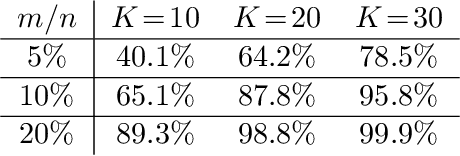



Abstract:Soft random sampling (SRS) is a simple yet effective approach for efficient training of large-scale deep neural networks when dealing with massive data. SRS selects a subset uniformly at random with replacement from the full data set in each epoch. In this paper, we conduct a theoretical and empirical analysis of SRS. First, we analyze its sampling dynamics including data coverage and occupancy. Next, we investigate its convergence with non-convex objective functions and give the convergence rate. Finally, we provide its generalization performance. We empirically evaluate SRS for image recognition on CIFAR10 and automatic speech recognition on Librispeech and an in-house payload dataset to demonstrate its effectiveness. Compared to existing coreset-based data selection methods, SRS offers a better accuracy-efficiency trade-off. Especially on real-world industrial scale data sets, it is shown to be a powerful training strategy with significant speedup and competitive performance with almost no additional computing cost.
Semi-Autoregressive Streaming ASR With Label Context
Sep 19, 2023Abstract:Non-autoregressive (NAR) modeling has gained significant interest in speech processing since these models achieve dramatically lower inference time than autoregressive (AR) models while also achieving good transcription accuracy. Since NAR automatic speech recognition (ASR) models must wait for the completion of the entire utterance before processing, some works explore streaming NAR models based on blockwise attention for low-latency applications. However, streaming NAR models significantly lag in accuracy compared to streaming AR and non-streaming NAR models. To address this, we propose a streaming "semi-autoregressive" ASR model that incorporates the labels emitted in previous blocks as additional context using a Language Model (LM) subnetwork. We also introduce a novel greedy decoding algorithm that addresses insertion and deletion errors near block boundaries while not significantly increasing the inference time. Experiments show that our method outperforms the existing streaming NAR model by 19% relative on Tedlium2, 16%/8% on Librispeech-100 clean/other test sets, and 19%/8% on the Switchboard(SWB) / Callhome(CH) test sets. It also reduced the accuracy gap with streaming AR and non-streaming NAR models while achieving 2.5x lower latency. We also demonstrate that our approach can effectively utilize external text data to pre-train the LM subnetwork to further improve streaming ASR accuracy.
 Add to Chrome
Add to Chrome Add to Firefox
Add to Firefox Add to Edge
Add to Edge